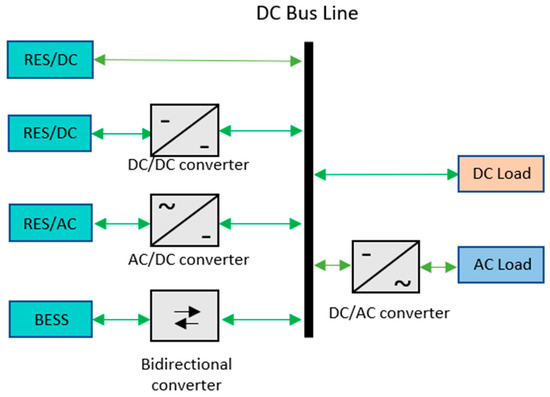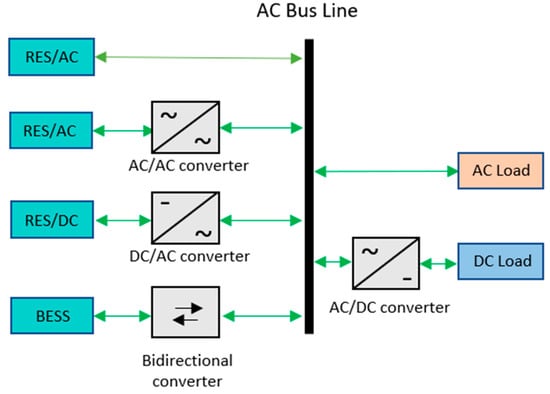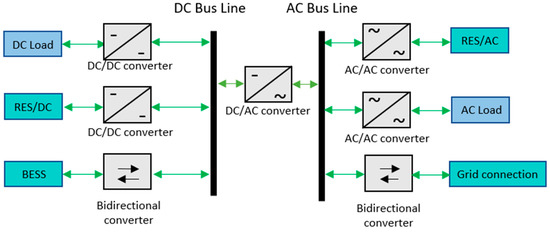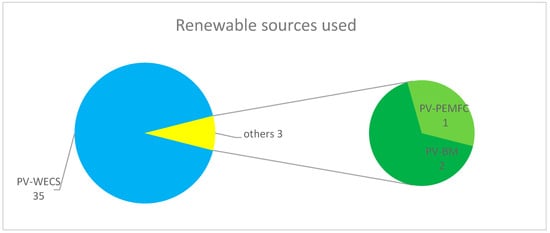Renewable energies are those sources of energy that can be obtained naturally without depleting the planet’s resources. Hybrid renewable energy systems are those that combine two or more renewable energy sources to generate electricity.
- hybrid renewable energy systems
- battery energy storage system
- optimization techniques
- optimization algorithms
1. Introduction
2. Renewable Energy Hybrid Systems
2.1. Composition of HRESs





The HRES system can include a BESS (battery energy storage system) to improve reliability. The BESS stores electrical energy generated by renewable sources, such as solar panels or wind turbines, and uses it at times of high energy demand or when renewable energy generation is reduced due to weather factors. In summary, the BESS is a key part of the HRES system to ensure a reliable and sustainable energy supply. Table 4 shows the most used BESSs, their advantages, and disadvantages.
| BESS | Advantages | Disadvantages | Articles Related to BESS |
|---|---|---|---|
| Energy storage in compressed air (CAES) | Lower cost, low self-discharge, high service life. | High initial cost, large scale, there are geographical restrictions that limit the installation of the system. | Not found |
| Battery Ni–Cd | Low maintenance requirement, high energy density and high reliability. | This product has high costs and suffers from a phenomenon known as “battery memory”. | Not found |
| Battery lead–acid | This product has a medium energy density, low initial investment, and is widely available. In addition, it does not require a cell management system. | The characteristics of this product” include a low life cycle, low efficiency, ventilation requirements, and the need for proper disposal of used batteries. | [7,14,16,17,18,19,20,23,34,57,59,60] |
| Battery Li-ion | This product stands out for its high efficiency, high energy density, long life cycle, and relatively compact size. In addition, it is in an area where rapid technological advances are taking place. | The disadvantages of this product are its high initial capital costs due to the special packaging required and the potential risk of battery body rupture. | [25,32,53] |
| Hydrogen-based (HESS) | This product is almost contamination-free and has a wide power range. | This product includes low efficiency, low response time, high cost, and installation restrictions due to the hydrogen storage tank. | Not found |
| Supercapacitor (SESS) | It has high efficiency, long life cycle, and high power capacity. | It has a low energy density and a relatively high cost. | Not found |
| Flywheel (FESS) | It features high power capacity, long life cycle, and fast charging capability. | Disadvantages of this product include its high cost due to the need for a separate vacuum chamber, safety issues, high self-discharge, and high cost. | [22] |
| Gel batteries | This product is a good choice for applications that have high cyclic requirements due to its excellent recharge behavior, which gives it a long service life. | One of the disadvantages of gel batteries is that they have a lower current capacity compared to other battery technologies. They can be more expensive than some other battery technologies. | [13] |
These auxiliary sources are typically used when the main source cannot generate enough power to meet demand at times of high demand or when the main source is inactive or unreliable. Common examples of auxiliary generation sources are diesel or natural gas generators.
2.2. HRES Sizing and Optimization
| Criteria | Type | Limitations | Articles Related to the Criteria |
|---|---|---|---|
| Annual system cost (ACS) | Economic | The cost estimate does not consider the possible variation of the interest rate and inflation. | Not found |
| Net current cost (NPC) | Economic | It is not possible to take into account fluctuations in fuel prices (in case conventional energy sources are included) and uncertainties in the durability of system components such as batteries. | [1,6,11,13,14,16,17,18,19,20,21,22,23,24,32,34,50,51,52,53,55,56,57,60,61,62] |
| Cost of energy (COE) | Economic | The cost of recovering system components at the end of their useful life is not included. | [12,13,14,16,17,19,20,21,23,28,30,32,33,34,50,51,52,53,55,56,60,62] |
| Levelized cost of energy (LCOE) | Economic | The cost estimation tool does not take into account external factors, such as volatility in fossil fuel prices and inflation. | [1,11,22,24,25,36,53,57] |
| Total net current cost (TNPC) | Economic | Changes in the cost of energy are not taken into account. | Not found |
| Life cycle cost (LCC) | Economic | Cost estimation is complicated by the difficulty of accurately predicting acquisition, operation, and long-term maintenance costs, which can affect the accuracy of the life cycle cost (LCC) analysis. | [13,15,31] |
| Cost of loss of battery life (LLCB) | Economic | Reduced battery performance as the battery ages is not included in the evaluation. | Not found |
Table 6. Optimization criteria (reliability) and limitations for HRESs [3,5].
| Criteria | Type | Limitations | Articles Related to the Criteria |
|---|---|---|---|
| Probability of loss of power supply (LPSP) | Reliability | It is defined for a specific load profile and does not take into account variations in that load profile. | [1,21,30,33,36,48] |
| Expected energy not supplied (EENS) | Reliability | The potential impact of variation in load demand is not taken into account. | Not found |
| Level of autonomy (LA) | Reliability | Normalized-to-total annual energy demand. | Not found |
| La probabilidad de pérdida de carga (LLP) | Reliability | A limitation in the assessment of power supply reliability is that long-duration load loss (LLP) only measures the probability of power supply interruption and does not provide a complete assessment of the reliability of the power system as a whole. | [52] |
| Deficiency in probability of power supply (DPSP) | reliability | For EPG < EL, it is the same as LPSP. | Not found |
2.3. Optimization Algorithms
3. Summary
This entry is adapted from the peer-reviewed paper 10.3390/eng4020084
